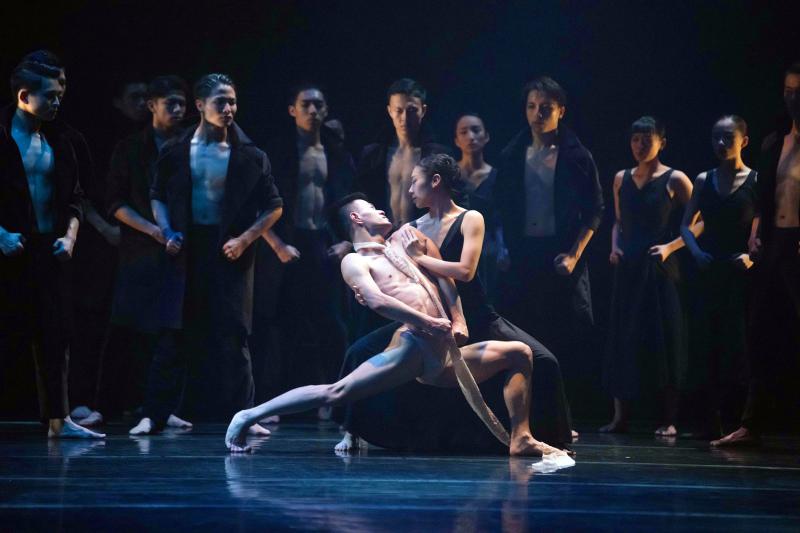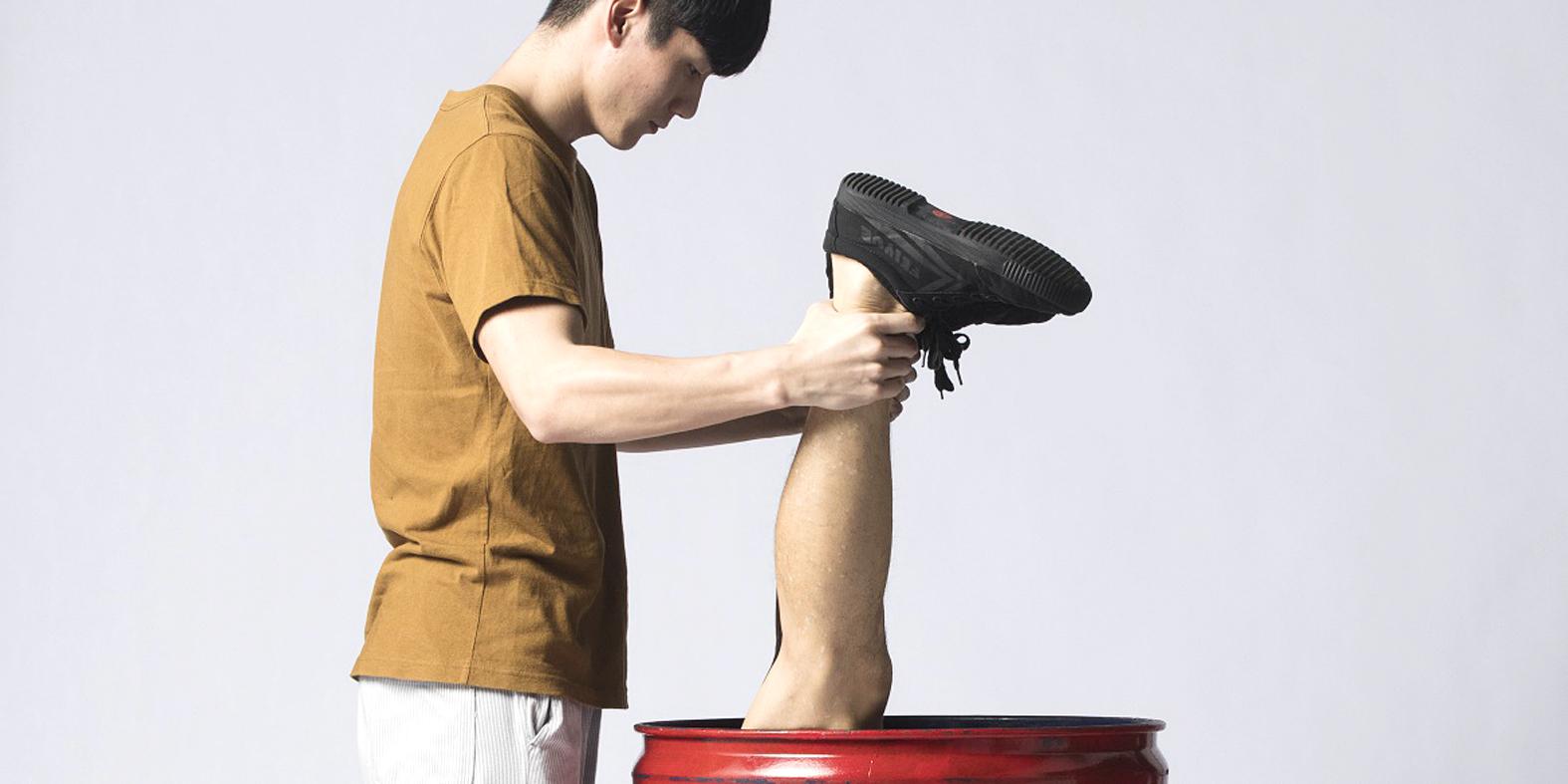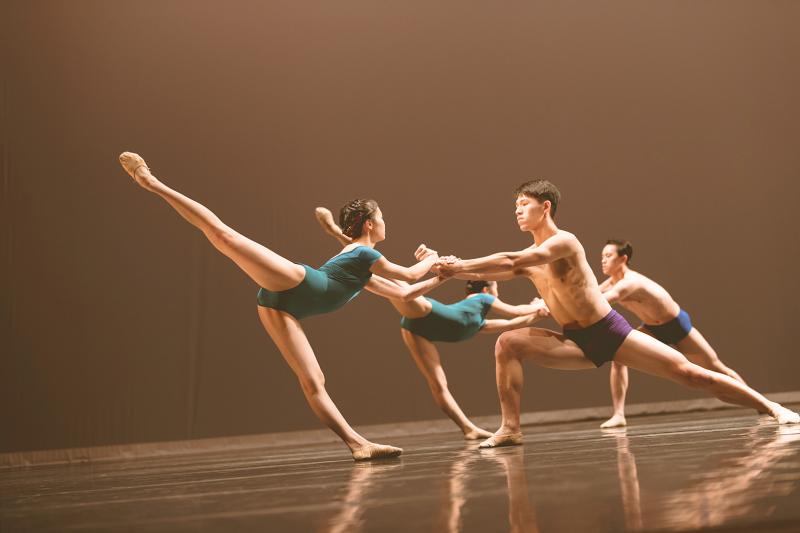This year’s Kuandu Arts Festival (關渡藝術節), which opened on Sept. 23 and runs through Nov. 29, is focused on music.
Under the theme “Joy of Music,” a nod to the 250th birthday of Ludwig van Beethoven, the program features performances by seven symphony orchestras as well as several Taipei National University of the Arts (TNUA, 國立臺北藝術大學) student and faculty shows, in addition to the annual film and animation festivals.
However, there is still room for other performing arts, and two productions this weekend and next at the university in the hills of Taipei’s Guandu area (關渡) feature students from the School of Dance.

Photo courtesy of Chang Chia-hou
The dance department is celebrating its 38th anniversary, so it is fitting that this weekend’s show, Four Chapters Of The Floating Life (浮生四闕), feature works ranging from ballet to contemporary to post-modern, choreographed by two faculty members, a guest professor and an alumnus.
The show’s artistic director, Chiang Chiou-o (蔣秋娥), choreographed 2020 Spring, a classical ballet-based work set to Max Richier’s take on the “Spring” section from Vivaldi’s The Four Seasons.
Alumnus and Batsheva dancer turned freelance dancer/choreographer Lee Chen-wei (李貞葳) has contributed Unfold Unpaid (非常非償), an exploration of the conflicts and disasters confronting modern society, set to music by Teho Teardo, Death Grips, Ben Frost and others.

Photo courtesy of the Kuandu Arts Festival
Australian Leigh Warren’s GREEN T, created for graduate students, is a three-part work inspired by the ideals of the postmodern movement and the pop culture of the time, set to music by John Cage and Steve Reich.
The final work on the program is The Floating Life (浮生) by Zhang Xiaoxiong (張曉雄), a restaging of a work he created for the 2006 Hong Kong Dance Academy Dance Festival, To Friends in Heaven.
Zhang adapted the piece for Taipei Crossover Dance Company (台北越界舞團) in 2008 and then restaged it this year for the students.

Photo courtesy of Formosa Circus Art
Set to Dmitri Shostakovich’s String Quartet No. 8, it is a powerful work focusing on the relationship between work and history, dance and music.
Back in 2008, he said it was about “people who could not choose the time and environment in which they lived, but who had the courage to face what they had to and the pride to do so.”
Then-TNUA student Wu Chien-wei (吳建緯) gave a mesmerizing performance in the 2008 production, and I am looking forward to seeing what the current crop of students do with it this time.

Photo courtesy of Wu Jun-yen
Zhang also choreographed another work for the festival, Through Mist And Rain (一蓑煙雨), which will be performed next weekend by TNUA students.
It is the latest installment of a collaboration between the university’s School of Music and School of Dance that began in 2018.
The first version of Through Mist And Rain debuted last year as a 30-minute work, but Zhang and his collaborators conducted additional research and field work to expand it to 60 minutes.
There are two shows, Saturday next week at 7:30pm and Sunday at 2:30pm in the Dance Theater and tickets are NT$600.
Meanwhile, dance is also key to a performance at the Cloud Gate Theater this week, with help from another TNUA alumnus.
The Formosa Circus Art (FOCA, 福爾摩沙馬戲團) troupe will perform the final installment of its crossover trilogy, Moss (苔痕).
Moss is a collaboration with the Germany-based Peculiar Man, founded by Tien Tsai-wei (田采薇), a dancer with Tanztheater Wuppertal Pina Bausch, and Jan Mollmer, and combines circus stunts and acrobatics with dance theater.
The idea was to focus on exploring the meaning behind the performance, and the production was inspired by a photograph of an abandoned building covered with vines, which conjured up the idea of a house of forgotten dreams and memories.
FOCA says the show explores loss, absence, presence and loneliness.

Feb. 17 to Feb. 23 “Japanese city is bombed,” screamed the banner in bold capital letters spanning the front page of the US daily New Castle News on Feb. 24, 1938. This was big news across the globe, as Japan had not been bombarded since Western forces attacked Shimonoseki in 1864. “Numerous Japanese citizens were killed and injured today when eight Chinese planes bombed Taihoku, capital of Formosa, and other nearby cities in the first Chinese air raid anywhere in the Japanese empire,” the subhead clarified. The target was the Matsuyama Airfield (today’s Songshan Airport in Taipei), which

China has begun recruiting for a planetary defense force after risk assessments determined that an asteroid could conceivably hit Earth in 2032. Job ads posted online by China’s State Administration of Science, Technology and Industry for National Defence (SASTIND) this week, sought young loyal graduates focused on aerospace engineering, international cooperation and asteroid detection. The recruitment drive comes amid increasing focus on an asteroid with a low — but growing — likelihood of hitting earth in seven years. The 2024 YR4 asteroid is at the top of the European and US space agencies’ risk lists, and last week analysts increased their probability

On Jan. 17, Beijing announced that it would allow residents of Shanghai and Fujian Province to visit Taiwan. The two sides are still working out the details. President William Lai (賴清德) has been promoting cross-strait tourism, perhaps to soften the People’s Republic of China’s (PRC) attitudes, perhaps as a sop to international and local opinion leaders. Likely the latter, since many observers understand that the twin drivers of cross-strait tourism — the belief that Chinese tourists will bring money into Taiwan, and the belief that tourism will create better relations — are both false. CHINESE TOURISM PIPE DREAM Back in July

Could Taiwan’s democracy be at risk? There is a lot of apocalyptic commentary right now suggesting that this is the case, but it is always a conspiracy by the other guys — our side is firmly on the side of protecting democracy and always has been, unlike them! The situation is nowhere near that bleak — yet. The concern is that the power struggle between the opposition Chinese Nationalist Party (KMT) and their now effectively pan-blue allies the Taiwan People’s Party (TPP) and the ruling Democratic Progressive Party (DPP) intensifies to the point where democratic functions start to break down. Both